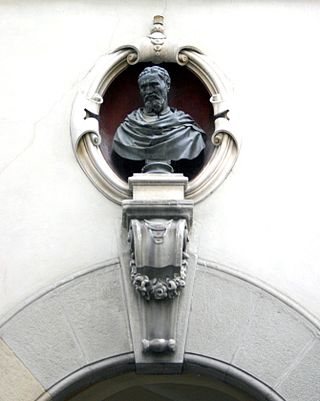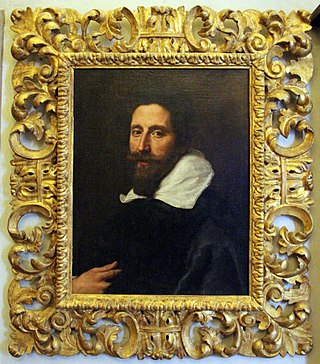
Michelangelo di Lodovico Buonarroti Simoni, known as Michelangelo, was an Italian sculptor, painter, architect, and poet of the High Renaissance. Born in the Republic of Florence, his work was inspired by models from classical antiquity and had a lasting influence on Western art. Michelangelo's creative abilities and mastery in a range of artistic arenas define him as an archetypal Renaissance man, along with his rival and elder contemporary, Leonardo da Vinci. Given the sheer volume of surviving correspondence, sketches, and reminiscences, Michelangelo is one of the best-documented artists of the 16th century. He was lauded by contemporary biographers as the most accomplished artist of his era.

The Madonna della Pietà informally known as La Pietà is a Roman Catholic dolorous image of Jesus and Mary at Mount Golgotha representing the "Sixth Sorrow" of the Blessed Virgin Mary and a key work of Italian Renaissance sculpture carved by Michelangelo Buonarroti, now enshrined within Saint Peter's Basilica, Vatican City. It is the first of a number of works of the same subject by the Florentine artist.
Ghirlandaio is the surname of a family of Renaissance Italian painters:

Filippo Giuseppe Maria Ludovico Buonarroti, more usually referred to under the French version Philippe Buonarroti, was an Italian utopian socialist, writer, agitator, freemason, and conspirator; he was active in Corsica, France, and Geneva. His History of Babeuf’s Conspiracy of Equals (1828) became a quintessential text for revolutionaries, inspiring such socialists as Blanqui and Marx. He proposed a mutualist strategy that would revolutionize society by stages, starting from monarchy to liberalism, then to radicalism, and finally to communism.
Carducci is an Italian surname. Notable people with the surname include:

The Madonna of the Stairs is a relief sculpture by Michelangelo in the Casa Buonarroti, Florence. It was sculpted around 1490, when Michelangelo was about fifteen. This and the Battle of the Centaurs were Michelangelo's first two sculptures. The first reference to the Madonna of the Stairs as a work by Michelangelo was in the 1568 edition of Giorgio Vasari's Lives of the Most Excellent Painters, Sculptors, and Architects.
Maestri is a surname of Italian origin. Notable people with the surname include:
Taddei is an Italian surname. Notable people with the surname include:

Marcello Venusti was an Italian Mannerist painter active in Rome in the mid-16th century.

Casa Buonarroti is a museum in Florence, Italy. The building was a property owned by the sculptor Michelangelo, which he left to his nephew, Leonardo Buonarroti. The house was converted into a museum dedicated to the artist by his great nephew, Michelangelo Buonarroti the Younger. Its collections include two of Michelangelo's earliest sculptures, the Madonna of the Stairs and the Battle of the Centaurs. A ten-thousand book library includes the family's archive and some of Michelangelo's letters and drawings. The Galleria is decorated with paintings commissioned by Buonarroti the Younger and created by Artemisia Gentileschi and other early seventeenth-century Italian artists.

Head of a Faun is a lost sculpture by Italian Renaissance master Michelangelo, dating from c. 1489. His first known work of sculpture in marble, it was sculpted when he was 15 or 16 as a copy of an antique work with some minor alterations. According to Giorgio Vasari's biography of the artist, it was the creation of this work that secured the young Michelangelo the patronage of Lorenzo de' Medici.

Tommaso dei Cavalieri was an Italian nobleman, who was the object of the greatest expression of Michelangelo's love. Michelangelo was 57 years old when he met Cavalieri in 1532. The young noble was exceptionally handsome, and his appearance seems to have fit the artist's notions of ideal masculine beauty, for Michelangelo described him as "light of our century, paragon of all the world". The two men remained close to each other throughout their lives and Cavalieri was present at the artist's death.
Unterberger is a German surname. Notable people with the surname include:

Michelangelo is a given name that is a combination of the Hebrew name Michael and the Greek name Angelo (messenger). The name itself is most commonly believed to be of Italian origin. The best known of that name is Michelangelo Buonarroti (1475–1564), the Tuscan sculptor, architect, painter, and poet.
Tamburini is an Italian surname. Notable people with the surname include:

Michelangelo Buonarroti il Giovane was a Florentine poet, librettist and man of letters, known as "the Younger" to distinguish him from his granduncle.
Calvi is an Italian surname. Notable people with the surname include:
Bonvicini is a surname. Notable people with the name include:
Antonioni is an Italian surname. Notable people with this surname include:
This page is based on this
Wikipedia article Text is available under the
CC BY-SA 4.0 license; additional terms may apply.
Images, videos and audio are available under their respective licenses.








